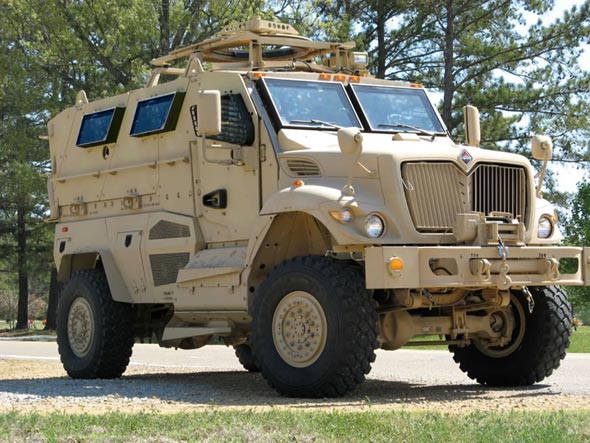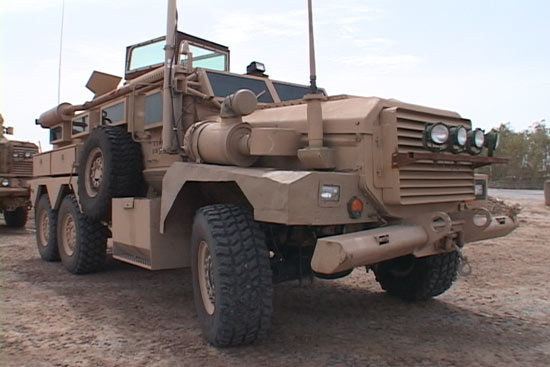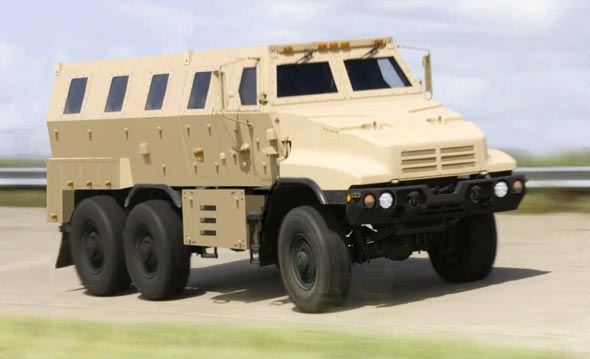The Pentagon has approved the expansion of the MRAP program to over 20,000 vehicles. The US Army plan to increase its fleet of MRAP vehicles from the planned 2,300 to 17,700. The Marines’s allocation will remain at 3,400 and special operations forces will receive about 300 (170 have already been ordered). This plans will virtually phase out the HMMWV from use in combat patrols and high risk missions. Responding to the urgent requirement, the Army plans to have all 17,700 MRAPs in theater by April 2009. To accomodate this plan all suppliers are expanding their production facilities to speed up deliveries, reaching several hundred vehicles per month by the autumn of 2007. By October 2007, 8800 vehicles are on order and the Pentagon expects 1,500 of them to be delivered to US forces in Iraq by the end of 2007.
The total procurement of MRAPs for all services could surpass 20,000 units, with an estimated procurement cost above $10 billion. However, the MRAP life cycle cost is expected to rise significantly above that level, due to the need for frequent damage repair resulting from high operational tempo and frequent battle damage. Some estimates value the program’s life cycle cost at about $20 billion. The up-armored Humvees proved vulnerable in Iraq and Afghanistan, resulting in the growing demand for vehicles that could better withstand roadside bomb blasts.
Between October and December 2006 the U.S. Navy evaluated nine suppliers for the procurement of Mine Resistant Ambush Protected (MRAP) trucks, destined to augment and later replace up-armored HMMWVs currently operating in Iraq and Afghanistan. The new vehicles provides much improved protection , specifically against Improvised Explosive Devices (IEDs), which cause 70% of all U.S. casualties in Iraq.
The initial joint services program, was expected to cost over US$2 billion is being managed by the US Marine Corps. However, given the poor performance of lightly armored vehicles in Iraq and Afghanistan, the realistic requirement for MRAP rose to over 7,700 vehicles, worth an approximate $8.4 billion. Some 3,700 MRAPS will go to the USMC while the Army plans to buy 2,500. The Army is expected to get much more than what it currently plans, as priorities are changed and additional funding allocated. MRAP is the “highest priority Department of Defense acquisition program,” Defense Secretary Robert Gates wrote in a memo sent in early May 2007 to the secretaries of the Army and Navy. Current forecasts based on urgent requirements directed by the Department of Defense, call for the rapid acquisition of 17,000 – 20,000 heavily armored MRAP vehicles, replacing protected HMMWV currently operating in theater. Despite the demand, manufacturers are producing the vehicles at full capacity and it is doubtful if they can increase production further in the near term.
Previous MRAP models (including Cougar JERRV and Buffalo mine protected trucks) are currently in service in Iraq and Afghanistan. These armored vehicles have a proven record of saving lives by augmenting the current level of mine, rocket propelled grenades and improvised explosive devices (IED) protection with a V-shaped hull and raised chassis.
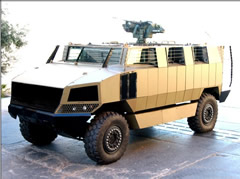 Of the original 4,100 vehicles included in the initial program, 1,500 will be Category I Mine Resistant Utility Vehicle (MRUV) (designed for the US Marines and U.S. Navy use) while 2,600 will be Category II Joint Explosive Ordnance Disposal Rapid Response Vehicle (JERRV) destined mostly for U.S. Army units.
Of the original 4,100 vehicles included in the initial program, 1,500 will be Category I Mine Resistant Utility Vehicle (MRUV) (designed for the US Marines and U.S. Navy use) while 2,600 will be Category II Joint Explosive Ordnance Disposal Rapid Response Vehicle (JERRV) destined mostly for U.S. Army units.
According to the original plans, the Army would get 2,500 vehicles, the USMC: 1,022 and Navy: 538. As mentioned above, the Army plans to significantly increase its procurement, with over 10,000 additional vehicles. Current MRAP, considered to be better protected against IEDs, mines and, if required – RPGs, is expected to significantly improve the protection of troops deployed in Iraq and Afghanistan. The vehicle will use bullet-proof armor and are designed with V shaped hull, deflecting the blast effect created by mines or IED explosions.
By February 23, over $200 million were awarded to five contractors for the low-rate initial production of some 400 vehicles, both category I and II MRAPs, including Cougars, RG-33Ls, Alpha, Golan and RG-31s. By April 24, an additional orders for more than 1,190 MRAP vehicles was awarded to Force Protection.
In July 2007 Armor Holdings’ Stewart Stevenson subsidiary received production orders for 1,170 Caiman model MRAP vehicles based on the company’s FMTV truck. The Caiman vehicle is based on Stewart Stevenson’s FMTV truck chasis, applied with bullet proof armor and IED protection to fulfil the MRAP mission.
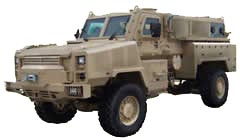 Further orders were issued to Oshkosh for 100 Alpha vehicles and to PVI for 60 Golan based MRAP were issued in March 2007. BAE Systems received orders for 90 4×4 and 6×6 RG-33s.
Further orders were issued to Oshkosh for 100 Alpha vehicles and to PVI for 60 Golan based MRAP were issued in March 2007. BAE Systems received orders for 90 4×4 and 6×6 RG-33s.
The U.S. Navy program office has allocated over US$34.5 million for the initial evaluation phase of 36 vehicles. Nine contracts have been awarded last week to most producers of armored vehicles, excluding AM General, (AMG) the producers of the HMMWV, which will continue production of the lighter, Up Armored vehicle under existing programs. The joint venture between AMG and AMG Each company will deliver four test vehicles (two per category), within 60 days. Among the contractors are some of the well established names, such as BAE Systems, GDLS and Force protection, and truck producers Oshkosh, International and Stewart & Stevenson (Armor Holdings) but also smaller producers of special armored vehicles, such as New Haven, Michigan based GPV and PVI, based in North Charleston, S.C. The full list of MRAP contractors include:
- BAE Systems, Ground Systems Division – RG-33
- Oshkosh Truck Corporation – Alpha (designed by PVI)
- Protected Vehicles, Inc. (PVI) – Golan, Alpha
- General Dynamics Land Systems – Canada – RG-31
- Force Protection Industries, Inc. – Cougar, Buffalo
- Armor Holdings, Inc. Armored FMTV
- International Military and Government LLC (APC)
 Due to the tight procurement schedule, only commercially available designs were considered. The vehicle should be designed for off-road and highway mobility, and be configured for personnel, cargo and litter transportation. Two versions of the targer truck size vehicles are considered – a Cougar sized, 38,000 pound (17 tons) vehicle with a payload capacity of 5,000 pounds (2.25 tons), that will be able to carry 6 – 10 troops (about 2,000 vehicles required). The vehicle will be configured to carry existing gunner protected turrets or remotely controlled weapon stations, enabling the gunner to load, operate and engage targets from fully protected positions. To improve recovery after mine damage, the vehicle will be built of modular components that could break away from the vehicle in the case of a blast. Its energy absorbing seats should be capable of withstanding the accelerative effects of mine blasts. The truck sub-category also includes a larger 45,000 pound (20 tons) armored truck, (Buffalo size) are also required by the USMC and Navy.
Due to the tight procurement schedule, only commercially available designs were considered. The vehicle should be designed for off-road and highway mobility, and be configured for personnel, cargo and litter transportation. Two versions of the targer truck size vehicles are considered – a Cougar sized, 38,000 pound (17 tons) vehicle with a payload capacity of 5,000 pounds (2.25 tons), that will be able to carry 6 – 10 troops (about 2,000 vehicles required). The vehicle will be configured to carry existing gunner protected turrets or remotely controlled weapon stations, enabling the gunner to load, operate and engage targets from fully protected positions. To improve recovery after mine damage, the vehicle will be built of modular components that could break away from the vehicle in the case of a blast. Its energy absorbing seats should be capable of withstanding the accelerative effects of mine blasts. The truck sub-category also includes a larger 45,000 pound (20 tons) armored truck, (Buffalo size) are also required by the USMC and Navy.Two truck manufacturers Oshkosh and International were selected among nine companies, each providing two Category I and two Category II vehicles for testing. The Category I vehicle is the smaller of the two vehicles, intended for urban operations and referred to as the Mine Resistant Utility Vehicle (MRUV). The Category II vehicle is a larger platform, designated as the Joint Explosive Ordnance Disposal Rapid Response Vehicle (JERRV), and is designed to carry up to 10 passengers on multiple types of missions.
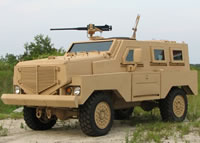 International Engines and Trucks (IET) has teamed with the Israeli armor expert Plasan Sasa to provide protected Mine Resistant, Ambush protected (MRAP) vehicles. The two companies have already completed another armoring design, fitting add-on armor cab to the MXT-MV utility vehicle. International’s trucks will utilize a modular concept to armor its trucks for the MRAP bid. The design maintains the standard chassis to ensure commonality and enable worldwide support, while assembling the modular, V-shaped crew compartment hull on top. The V-shaped hull helps to deflect any blasts from underneath the truck to dissipate around the crew area, minimizing damage. The chassis types selected for the bid include commercial trucks built to carry heavy loads, therefore accommodating the weight of protective armor built into the truck design. This design maintains the vehicle’s maneuverability even under full loads.
International Engines and Trucks (IET) has teamed with the Israeli armor expert Plasan Sasa to provide protected Mine Resistant, Ambush protected (MRAP) vehicles. The two companies have already completed another armoring design, fitting add-on armor cab to the MXT-MV utility vehicle. International’s trucks will utilize a modular concept to armor its trucks for the MRAP bid. The design maintains the standard chassis to ensure commonality and enable worldwide support, while assembling the modular, V-shaped crew compartment hull on top. The V-shaped hull helps to deflect any blasts from underneath the truck to dissipate around the crew area, minimizing damage. The chassis types selected for the bid include commercial trucks built to carry heavy loads, therefore accommodating the weight of protective armor built into the truck design. This design maintains the vehicle’s maneuverability even under full loads.
International’s has an armor integration center in Mississippi, and is teamed with Israeli armor expert Plasan Sasa to design and produce the protection suit for International’s MRAP model. In March 2007 the company will deliver to the U.S. Marines four vehicles for testing. In June 2007 International receivd an initial order for 1,200 Category I MRAP vehicles.
The armor protection of the vehicle include mine protection and ballistic protection of the full, roof protection from overhead airburst and side protection against fragmentation and blast. The transparent armor windows will have protection level equal to or greater than that of the ballistic armor on the vehicle, and will have built-in gun-ports. RPG protection could also be an option.
An updated review of the MRAP program is available in the February 2007 edition of National Defense Magazine.

